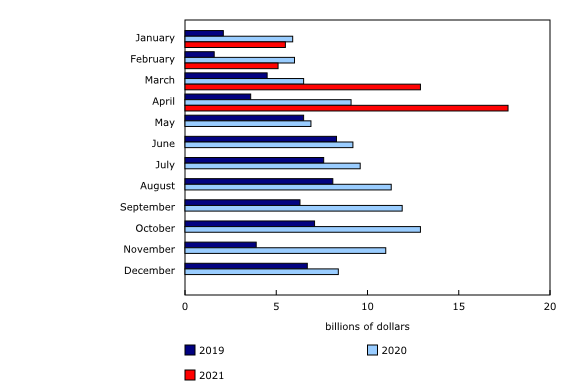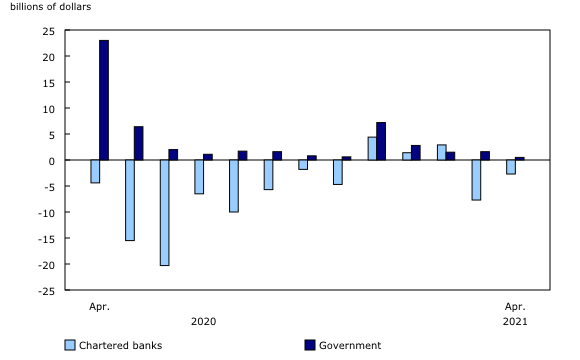Monthly credit aggregates, April 2021
Archived Content
Information identified as archived is provided for reference, research or recordkeeping purposes. It is not subject to the Government of Canada Web Standards and has not been altered or updated since it was archived. Please "contact us" to request a format other than those available.
Released: 2021-06-18
Household mortgage borrowing grows by record amount
Household sector borrowing is divided into financing in the form of non-mortgage loans, or funds principally for consumption, and mortgage loans, or debt acquired to finance the purchase of a property.
By the end of April, household mortgage debt had grown by $17.7 billion, following a sizable increase in March (+$12.9 billion); the April pace of borrowing set a record for the largest month-over-month increase. Compared with April 2020, household mortgage debt was up 7.8%. Sales of existing homes declined from the previous month's record volumes, but they remained elevated in April.
Non-mortgage debt edged up 0.2% in April to reach $782.7 billion, but it had yet to reach the levels recorded at the end of 2019, as consumers faced new restrictions related to the increase in COVID-19 cases in the month. While lower credit card balances persisted, other loan products, such as personal loans and lines of credit, were up in the month.
Overall, the total credit liabilities of households reached $2,482.3 billion by the end of April. Real estate secured debt, composed of both mortgage debt and home equity lines of credit, stood at $1,961.9 billion.
Private non-financial corporation borrowing continues decline
In April, private non-financial corporations reduced their outstanding non-mortgage loan liabilities by a further $3.3 billion, after a decline in March. Non-mortgage loans from chartered banks fell $2.7 billion, while new funds provided by the federal government rose at a slower pace (+$0.5 billion). In terms of debt securities, private non-financial corporations recorded net retirements in both long-term and short-term securities for an overall total of $2.2 billion in April, a reversal from the net issuances of March.
Overall, total credit liabilities of private non-financial corporations totalled $2,839.0 billion by the end of the month of April.
Note to readers
Overview of the monthly credit aggregates
The monthly credit aggregates break down a portion of the quarterly National Balance Sheet Accounts (NBSA) by month. They provide details on lending to households and non-financial corporations—in other words, the stock of these sectors' outstanding liabilities from the debtor perspective—across a range of credit instruments, including mortgage loans, non-mortgage loans, and debt and equity securities. The aggregates cover all lending sectors, including chartered banks, non-bank deposit-taking institutions, other financial corporations, government and other lenders. The estimates are presented as booked-in-Canada to capture activity within Canada with either domestic or non-resident lenders. Additionally, amounts are reported on an end-of-period basis (i.e., the value of the stock of an asset on the final day of the month). The third month of each quarter is benchmarked to the corresponding quarterly release of the NBSA.
The NBSA are composed of the balance sheets of all sectors and subsectors of the economy. The main sectors are households, non-profit institutions serving households, financial corporations, non-financial corporations, government and non-residents. The NBSA cover all national non-financial assets and all financial asset-liability claims outstanding in all sectors and—similarly—they present stocks as of the end of each quarter.
Estimates are available on a seasonally adjusted basis to improve the interpretability of period-to-period changes in debt. For information on seasonal adjustment, see Seasonally adjusted data – Frequently asked questions.
For more information on the concepts, methodologies and classifications used to compile these monthly estimates, please see the document "Guide to the Monthly Credit Aggregates."
Next release
Data on the monthly credit aggregates for May will be released on July 20, 2021.
Products
The document "Guide to the Monthly Credit Aggregates," which is part of Latest Developments in the Canadian Economic Accounts (13-605-X), is available.
The document "An overview of revisions to the Financial and Wealth Accounts, 1990 to 2020," which is part of Latest Developments in the Canadian Economic Accounts (13-605-X), is available.
The data visualization product "Financial accounts on a from-whom-to-whom basis, selected financial instruments," which is part of Statistics Canada – Data Visualization Products (71-607-X), is available.
The data visualization product "Distributions of Household Economic Accounts, Wealth: Interactive tool," which is part of Statistics Canada – Data Visualization Products (71-607-X), is available.
The data visualization product "Securities statistics," which is part of Statistics Canada – Data Visualization Products (71-607-X), is available.
The Economic accounts statistics portal, accessible from the Subjects module of our website, provides an up-to-date portrait of national and provincial economies and their structure.
The User Guide: Canadian System of Macroeconomic Accounts (13-606-G) is available.
The Methodological Guide: Canadian System of Macroeconomic Accounts (13-607-X) is available.
Contact information
For more information, or to enquire about the concepts, methods or data quality of this release, contact us (toll-free 1-800-263-1136; 514-283-8300; STATCAN.infostats-infostats.STATCAN@canada.ca) or Media Relations (613-951-4636; STATCAN.mediahotline-ligneinfomedias.STATCAN@canada.ca).
- Date modified:



